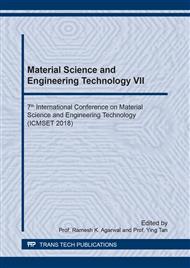p.55
p.60
p.65
p.70
p.75
p.80
p.85
p.90
p.97
Application of Electric Field during the Heat Treatment: The Device Development and the Effect on Mechanical Properties of AA 6082
Abstract:
With the ever-increasing concern about the energy and environment crises, aluminum alloys are becoming increasingly desirable in the automotive, aerospace, construction and other related industries due to their high specific strength. Various heat-treatment–stamping integrated techniques have been invented to address the formability challenge of aluminum alloy sheets. Electric field affects the heat treatment process of aluminum alloys. In this paper, a device for application of electric field during the heat treatment was developed. The maximum dimensions of specimen are determined via observing the distortion of metal sheets after quenching in cool water. The high-temperature resistant pure nickel wire gains a high-voltage proof performance by wearing bowl-shaped porcelain tubes, and is used to connect electrodes to power supply. The high-voltage resistant mica plates are bolted together to fill the gap between the specimen and electrode. This device was then used in a common commercial furnace to study the effect of electric field applied during the heat treatment on mechanical properties of AA 6082 sheets. It is found that electric field could enhance mechanical properties of AA 6082. The application of electric field has a potential to lower the cost of heat-treatment–stamping integrated techniques.
Info:
Periodical:
Pages:
75-79
Citation:
Online since:
April 2019
Authors:
Keywords:
Price:
Сopyright:
© 2019 Trans Tech Publications Ltd. All Rights Reserved
Share:
Citation:


